

The Visit (c. 1657) by Pieter De Hooch

Artwork Information
About the visit.
Pieter De Hooch’s oil on wood painting, The Visit, depicts a group of figures enjoying each other’s company in a domestic setting. Measuring 26 3/4 x 23 inches, the painting falls under the genre of Merry Company and is characterized by its small size and finely nuanced observation of everyday living. De Hooch was known for his cultured treatment of color and light, with variations in tone and perspective evident in his works.
The Visit was painted around 1657 during De Hooch’s transitional phase towards utilizing a darker and richer range of colors. Similar to his contemporary Jan Vermeer, De Hooch had an interest in portraying fashionable life in Amsterdam and often depicted the domestic life of women and children. The delicate treatment of light evident in The Visit is reminiscent of Vermeer’s style while highlighting De Hooch’s own unique artistic approach.
Currently housed at The Metropolitan Museum of Art in Manhattan, The Visit holds significance as one of the first works where De Hooch used linear perspective to construct a realistic interior space. As the eldest child who outlived all his siblings, Pieter De Hooch left behind a body of work that reflects his sense for capturing scenes from everyday life with precision whilst evoking emotion through nuanced touches such as varied thresholds or glimpses into adjoining rooms that hint at intricate human stories taking place outside the viewfinder.
Other Artwork from Pieter De Hooch

Portrait Of A Family In A Courtyard In Delft (c. 1658-60) by Pieter De Hooch

A Man Offering A Glass Of Wine To A Woman (c. 1654-55) by Pieter De Hooch

Pieter De Hooch Biography and Artwork

Two Soldiers And A Serving Woman With A Trumpeter (c. 1654-55) by Pieter De Hooch

A Mother and Child with Its Head in Her Lap (Maternal Duty) (c. 1658-60) by Pieter de Hooch

Figures Drinking In A Courtyard (1658) by Pieter De Hooch
More artwork from artchive.

Lydia In A Loge, Wearing A Pearl Necklace (1879) by Mary Cassatt

Paysage À Maintenon (1918) by Henri Matisse

The Pewter Jug (1917) by Henri Matisse

The Idol (1906) by Henri Matisse

Portrait of Yvonne (1919) by Henri Matisse

Self-portrait With Raised Right Elbow (1914) by Egon Schiele

Standing Figure (1906) by Henri Matisse

Still Life, Peaches and Glass (1916) by Henri Matisse

The Beheading of John the Baptist by Carel Fabritius

“Freddie Mercury” (2023) by Jimmy Law

Girl in White with a Bouquet (1919) by Henri Matisse

All About The Visit by Pieter de Hooch

Title of Artwork: “The Visit”
Related posts.

Empire of Light: Exploring the Mystique and Magic of René Magritte’s Iconic Painting

Suzuki Hiroshima: A Masterpiece by Jean Tinguely

Top Street Art Spots in London

Snapshot: London’s Photo Exhibits
Also known as ‘merry company with two men and two women’.

Artwork by Pieter de Hooch
Year created 1657, summary of the visit.
The Merry Company with Two Men and Two Women (1657) by Dutch artist Pieter de Hooch is a great example of how popular this type of painting was during the Dutch Golden Age. It shows a group of people who aren’t supposed to be recognized as portraits having fun. It is now at the Metropolitan Museum of Art, New York.
All About The Visit
In 1910, Hofstede de Groot commented about this painting by Hooch, noting, “Two ladies and two gentlemen are seated inside a house in 192. Sm. 34. The party is gathered in the left-hand corner of a room, beside a wide window, the upper half of which is fastened back.
A young woman, dressed in a red jacket with white fur trim, a blue skirt, and a huge white apron, stands at the table’s left corner and pours wine for the guests. A young man in a white suit, complete with a wide collar and a bowler hat, stands behind the table, smoking a pipe, and eyes the girl from behind.
There’s a man to the right of the table wearing a black cape and long curls that obscure his face. He takes the arm of a girl who sits next to them and watches him with a mix of suspicion and amusement on her face. His sloppy cap is in the foreground, off to the right.
There is a curtained bed in the backdrop on the right, a portrait of a guy hanging above it, and a map of a Dutch harbor to the left of the portrait. The direction of light is left. The use of light and color is beautifully done, making for a striking and effective image. Burger thought it was a Vermeer; for proof, see Vol. 14, No. 551 of the 1866 Gazette des Beaux-Arts. Size of the panel is 27″ x 22 1/2″.
Dated 1833 and housed in the library of Baron Delessert (Sm.), The No. 36 Sales Bulletin, Francois Delessert, Paris, May 15, 1869 (150,000 francs). Paris, France, 5 April 1883: B. Narischkine (160,000 francs). A Secret Meeting in Paris on July 1st, 1889 cost 270,000 francs. After that, it ended up in Paris with Durand-Ruel. “Currently on display in New York’s Havemeyer collection.”
Information Citations:
En.wikipedia.org, https://en.wikipedia.org/.

Oh hi there 👋 It’s nice to meet you.
Sign up to receive awesome content in your inbox from us.
We don’t spam!
Check your inbox or spam folder to confirm your subscription.
All About The Shadow of Death by William Holman Hunt
All about unexpected visitors by ilya repin, creative flair.
Official Creative Flair Account

The world of art is filled with masterpieces that evoke powerful emotions and provoke...

"Suzuki Hiroshima" is an iconic artwork created in 1963 by the Swiss artist Jean...

1. Camden - The Eclectic Hub of Creativity Camden beautifully fuses diverse cultures into...

London's vibrant photography scene is a pulsating heart for visual culture, offering a rich...

All Hidden Symbols & Meanings In Picasso’s Guernica

Van Gogh’s “Starry Night”: Symbols, Techniques, and Impact

Are Art Prints Really Worth Anything? Or Are You Just Wasting Your Money

The Guitar Lesson by Balthus: Exploring Themes, Symbolism, and Controversy

Censorship in the Art World and Its Impact on Creativity

Guernica’s Echo in Modern Culture
Subscribe to our newsletter.
Sign Up for our Newsletter
Most popular.

Rare Teenage Photos Surface of Banksy Before His Rise to Fame

The Art of Royalty: Analyzing the New Portrait of King Charles III & WHY IT’S ACTUALLY GOOD

10 Optical Illusions In Famous Works Of Art

Frida Kahlo’s Emotional Art

Depression in the Art World: A Crucial Catalyst for Creativity

Starry Night Art Critiques

© 2024 Creative Flair Blog

Navigate Site
- Main Website
Welcome Back!
Login to your account below
Remember Me
Create New Account!
Fill the forms below to register
Retrieve your password
Please enter your username or email address to reset your password.
Are you sure want to unlock this post?
Are you sure want to cancel subscription.

Pieter de Hooch
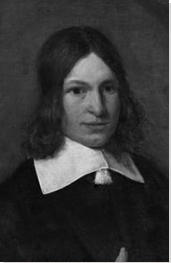
Dutch Golden Age Painter

Summary of Pieter de Hooch
De Hooch is renowned as a painter of interiors and courtyards featuring sophisticated spatial arrangements and virtuoso atmospheric lighting effects. With contemporaries Gerrit Dou, Gabriel Metso and Johannes Vermeer , he played a central role in the promotion of Dutch genre painting during the seventeenth century. Almost habitually compared to Vermeer, historians are apt to debate who exerted more influence over who, though de Hooch, though less gifted, was undoubtedly the more versatile and prolific of the two Delft painters. For all his famous colleague's superior handling of the adult human figure, it is de Hooch who emerges as the painter of children and as the "master of interiors". He created unsentimental vignettes acted out in courtyards and superbly furnished rooms realized through fine attention to detail and complex picture perspectives that typically featured his signature doorkirkjie - or "see-through-doorway" - technique. Though the intimate quality of his work deteriorated in later years (a decline that has been attributed to a series of profound personal tragedies), he remains one of the most important figures of the Golden Age of Dutch painting .
Accomplishments
- De Hooch's works, which were generally small in size, revealed the artist's finely nuanced observation of the fleeting details of everyday living; his cultured treatment of color and light and his variations in tone and perspective making him comparable only to Vermeer. The artist's virtuoso command of perspective and responsiveness to light intensity was unprecedented in seventeenth century Dutch painting and set new standards of authenticity for interior domestic narratives.
- Creating what were, in effect, "pictures within pictures", de Hooch is considered the pioneer of the doorkirkjie technique. Complementing the main picture narrative, his "see-through" doors expanded the scope of the picture plane to offer a more involved method of storytelling. Indeed, by offering the viewer a glimpse of the architectural world adjacent to, but beyond, the walls of the interior space he provided inspiration for many of his contemporaries.
- In General, de Hooch adopted a straightforward approach to his subject and did not resort to moralizing or symbolic excesses. Though they are intimate and kindly in character, often focusing on women and children for their human interest, his best works brought a new level of respectability to the genre which had historically treated such material with a mawkish sentimentality.
- De Hooch's exquisite handling of lighting effects are abundantly evident in his skill of creating the illusion of looking into a living domestic space. He was a trailblazer in capturing light on ceramics, polished wood and glass but the artist had a specially fine eye for slightly crumbling exterior walls that revealed exposed areas of mortar. As Sue Herdman, Editor-in-Chief of The Arts Society Magazine, noted, de Hooch "'builds' his house on canvas, one brick at a time, each just centimetres large, using the tiniest brush strokes of red paint".
The Life of Pieter de Hooch
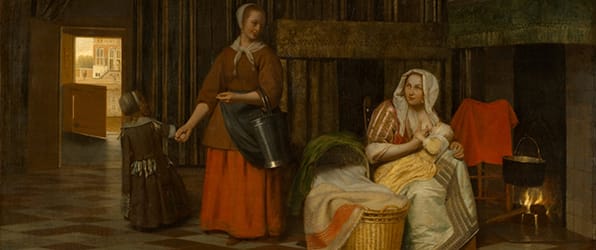
Pieter de Hooch is best known for his skill at rendering domestic interiors, and for his invention of the doorkirkjie , or “see-through-doorway", technique, bringing the exterior world into the frame, thus emphasizing the home as a safe haven for families to live out their pious lives.
Important Art by Pieter de Hooch
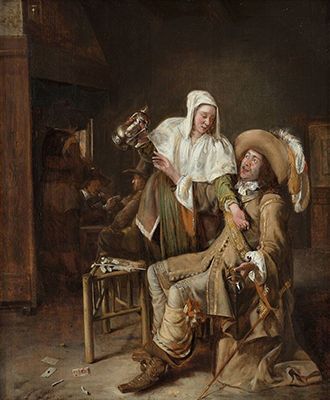
The Empty Glass
De Hooch's early paintings, known as " koortegardje " pictures, showed scenes of disorderly soldiers in stables and taverns depicted through shades of dark browns and yellows. The Empty Glass painting shows just such a tavern interior. In the foreground, a seated soldier, who appears drunk (due to his red nose and overly jovial expression and gesture) is handing his empty glass to a barmaid who holds a pitcher of wine. In the dark background of the tavern sit two men playing cards. On the floor lays discarded playing cards and cigarettes. Although these works bear the hallmarks of Dutch painter Adriaen van Ostade, de Hooch used the genre to finesse his skills in lighting, color, and perspective. Comparisons have also been drawn between his works and the tavern interiors by his contemporaries, Gerard ter Borch, Gerbrand van den Eeckhout, Ludolf de Jongh, and Pieter Codde, particularly in terms of the palette of browns and yellows, and the painting's chiaroscuro effects. Shortly after he produced this work, De Hooch moved to Delft, where he abandoned tavern scenes in favor of the popular genre paintings and domestic scenes. His domestic scenes were characterized by quiet and order, and served as models for a fully realized Calvinist family life. What citizens of the newly independent Dutch Republic wanted were not scenes of rambunctious drunkards, but images that foregrounded the importance of the stable family unit, which was seen as foundational to the health and resilience of the Republic.
Oil on panel - Museum Boijmans Van Beuningen, Rotterdam, The Netherlands
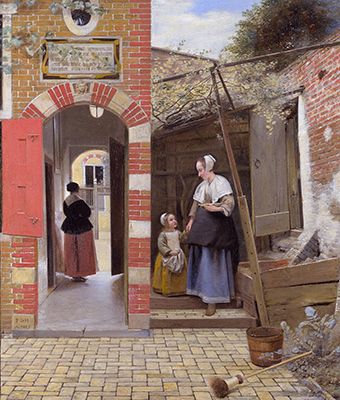
The Courtyard of a House in Delft
In this work, the setting is an interior domestic courtyard. A woman and a young girl enter the courtyard hand in hand. The pair look lovingly into one another's eyes suggesting a mother/daughter relationship. To their right, we look through a brick and stone archway onto an open doorway, where another woman, dressed in black and red, stands with her back to the viewer looking out onto the adjoining street. Above the archway, a stone tablet in the wall reads "This is in Saint Jerome's dale, please be patient and meek, for we must first descend, if we wish to be raised. 1614″. On the floor of the courtyard lie a broom and bucket. To the top right, blue sky and fluffy white clouds can be seen. Around the mid-1650s, de Hooch stopped painting soldiers and peasants, and began to focus instead on domestic scenes featuring the middle classes engaged in quotidian activities. In most of these works, the interaction between the figures is restrained, giving the scenes a sense of stillness, and in the case of mother-child tableaux (of which he painted several), a sense of intimacy. Art historian Simon Schama asserts in fact that de Hooch provided "the first sustained image of parental love that European art has shown us". These domestic interiors are considered to be de Hooch's greatest works, and were popular subjects for many Delft School painters, and Golden Age Dutch painters generally. Curator Alejandro Vergara suggests that de Hooch's work shows the influence of Nicolaes Maes, "Particularly the dignity of the treatment of domestic subjects, [...] and above all, the geometry of the spaces and the warmth of the light which illuminates them". Vergara adds that de Hooch organizes space "following a strict geometry" and that in his works, "light plays a key role, creating strong contrasts between the illuminated areas and those left in shade and emphasizing the differences between the various materials".
Oil on canvas - The National Gallery, London
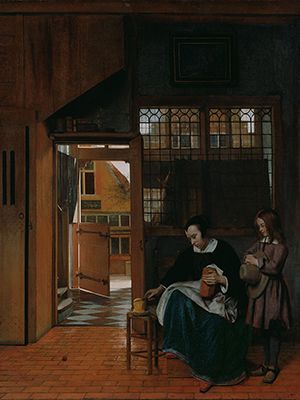
A Woman Preparing Bread and Butter for a Boy
This painting, one of few surviving works from de Hooch's early years in Amsterdam (before the deaths of his wife and two of his children), shows a domestic interior, with a doorkirkjie to the left leading out to the street. To the right are a seated woman dressed in a black jacket and blue skirt, and a young boy standing to her right, wearing red and clutching a hat under his folded hands. The woman has a loaf of bread on her lap, and is carving a piece of butter from a plate on a chair to her left. The boy's folded hands indicate that he is saying grace before receiving his morning meal. We can assume that after eating, he will head to the school visible through the doorkirkjie . De Hooch and his contemporaries often included simple symbolism in their domestic interiors in order to convey moral lessons regarding education, child-rearing, and the importance of keeping busy. In this painting, for instance, the books and candle in the niche above the doorway symbolize enlightenment through education. The small top lying on the floor in front of the door likely refers to a Dutch proverb that states that a child and a top will both fall idle unless continually "whipped" (a toy spinning top that has to be "spun" by striking it with a stick). In de Hooch's work, his meticulous rendering of architectural elements like brick and stonework indicate that he learned some aspects of masonry from his bricklayer father. But these elements can also be read for their moral and religious overtones by communicating the importance of maintaining order and simplicity within the private home. The interior space is dark, moreover, and this contrasts with the daylight spilling through the front door. The dark interior connotes, perhaps, the importance of leading a still and deferential life.
Oil on canvas - Getty Center, Los Angeles, California
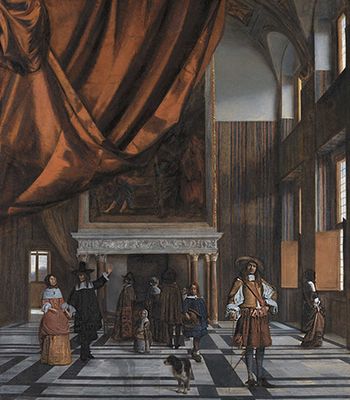
The Council Chamber in Amsterdam Town Hall
De Hoochshows one of two mayor's rooms of Amsterdam Town Hall, with its patterned black and white marble floors, high ceiling, double bay windows, and impressive chimney-piece with a cornice and frieze supported on pilasters. To the left, we see a second room and window through an open doorway. The upper-left section of the image is dominated by a red curtain. The painting serves as an important historical document as it faithfully represents the day-to-day activity in the city's civic offices. Several figures populate the scene, all of whom are upper/middle-class individuals and families enjoying their visit to one of Amsterdam's most important buildings. To the left, a woman dressed in red and yellow holds hands with a man dressed in black who gestures with his left hand at the vaunted ceiling. They appear to have just arrived. At the centre, in front of the fireplace, is a group of people that includes two men, one woman, and three children. In front of them is a dog. To the right stands a solitary man carrying a stick facing the viewer, and behind him, a solitary woman, seen in profile, gazing out the window. During the 1660s, De Hooch began to paint for wealthier patrons in Amsterdam, and he became known for his "merry company" scenes and family portraits in opulent interiors (as opposed to his previous domestic interiors), with marble floors and high ceilings (influenced by an increasing taste for French art and culture). Amsterdam's Town Hall became one of his favorite settings (the building also appeared in his Musical Party in a Hall (1663-65), and Going for a Walk in the Amsterdam Town Hall (1663-65)). This painting exemplifies de Hooch's talent for using various lighting sources to create a play of shadows. The work also demonstrates de Hooch's skill in architectural views and perspective, something he likely learned from Carel Fabritius.
Oil on canvas - Museo Nacional Thyssen-Bornemisza, Madrid, Spain
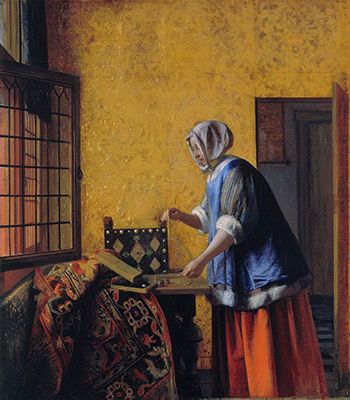
Interior with a Woman Weighing Gold Coin
In this mature work, a wealthy woman, signified through her blue top trimmed with fur and her fine red skirt, stands in front of a small table, holding a small scale with her right hand, and picking up coins with her left. A patterned carpet is hung over the corner of the table. The wall behind the woman is painted vibrant gold. To the right is an open door, through which we see another room and a second closed door. To the left of the frame, finally, de Hooch paints an open window. According to curator Alejandro Vergara "The quality of light in [de Hooch's] paintings and the pleasure with which he recreates the textures and the beauty of everyday objects contributes to the welcoming, comforting mood of his interiors. The great innovation of de Hooch's painting is the importance which it gives to the middle-class setting, while its most unique quality is the absolutely convincing naturalism of his paintings which rely on the treatment of light and space and the psychological proximity of the figures. As we stand before one of De Hooch's paintings, we feel that we have stepped inside a seventeenth-century home". This painting is frequently compared to Johannes Vermeer's Woman Holding a Balance (also from 1664). Indeed, many of de Hooch's and Vermeer's works are similar in style and subject matter, and scholars continue to debate which artist exerted the greater influence over the other. Study of this work and its preparatory drawings indicates that de Hooch's slightly pre-empts Vermeer's painting. Vergara argues that "De Hooch's sensibility towards the effect which the representation of space has on the psychological mood of a painting may have influenced Vermeer. Other shared features such as their interest in describing textures and the effects of light on materials, are the result of shared sensibilities which they must have mutually reinforced".
Oil on canvas - Gemäldegalerie, Berlin, Germany
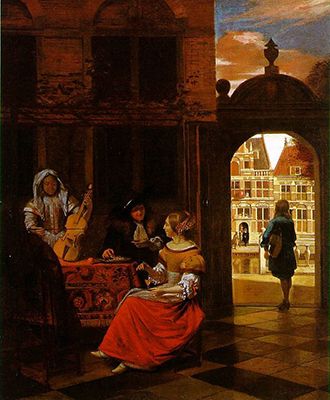
A Musical Party in a Courtyard
In A Musical Party in a Courtyard , three people (two women and one man) are seated in a dark courtyard, enjoying their leisure time together. The woman at the far left plays a violin. The man smiles at the second woman. The figures all wear fashionable clothing and fine jewelry, and on the table lays an expensive Turkish rug. A fourth figure, with his back to the viewer, stands in the arched doorway at the right of the frame, looking out at the street, the canal, and the houses beyond. Despite the opulent elements (the carpet, clothing, and jewelry) depicted in this painting, de Hooch does not render the courtyard architecture in any detail, instead giving us only a glimpse of the area. Curator Arthur K. Wheelock Jr. writes that, by the 1670, "De Hooch's work had lost much of its delicacy and finesse. His later compositions be¬came grander and more contrived, and his color harmonies and light effects harsher". The only section of this work which bears the lightness and fine detail of his earlier masterpieces is the city view seen through the doorway. It is generally surmised that the quality of de Hooch's work suffered due to his grief and anguish following the death of his wife and two of his children in the 1660s.
Biography of Pieter de Hooch
Little is known about de Hooch (sometimes spelled Hoogh) since only a handful of documents directly connected to him are known to historians. It is agreed however that he was the eldest of five children and was baptized on, or shortly after, his birth date in the Reformed Church in Rotterdam. His father was a master bricklayer (who may have had a influence on his son's painterly interest building materials such as brick and tile) while his mother, a midwife, passed away when her children were very young. It is also known that de Hooch outlived all four of his siblings.
Education and Early Training
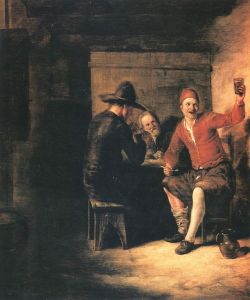
Though the exact dates are not recorded, de Hooch served his apprenticeships under two painters, the " vroedschap " ("wise man") Ludolph de Jongh in Rotterdam, and later, Nicolaes Pietersz Berchem, one of the leading Dutch painters of Italianate landscapes, in Haarlem. While at Haarlem he befriended fellow pupil Jacob Ochtervelt, himself destined to become the leading specialist in aristocratic genre painting. De Hooch showed little or no interest in landscapes, however, with all his early paintings being so-called " koortegardje " pictures: scenes of rowdy soldiers in stables or taverns rendered in shades of dark browns and yellows. He soon graduated to " kamergezichten " ("room-views") featuring middle-class subjects in informal conversation. He appears to have drawn inspiration from Hendrik Sorgh, a fellow Rotterdam painter known for his skill in organizing figures in interiors.
It was commonplace for artists of the day to have a second trade and, in 1650, de Hooch began working as a painter and dienaar (servant or assistant) for the Rotterdam linen merchant and art collector, Justus de la Grange. His work involved accompanying de la Grange on trips to The Hague, Leiden, and Delft. As well as learning the cloth trade, it is believed that De Hooch exchanged many of his early works (at least eleven paintings) for housing and other benefits. In 1652 de Hooch relocated to Delft where he met and married (in 1654) Jannetje van der Burch. Pieter and Jannetje (very probably the sister of the painter Hendrick van der Burch) had seven children.
Mature Period
De Hooch entered the guild of Saint Luke in Delft as an independent painter in 1655 and is recorded as having paid dues in 1656 and 1657. He studied under guild painters Carel Fabritius and Nicolaes Maes, and, given the many similarities in their painting style, there is universal agreement that he crossed paths with Johannes Vermeer (who also lived in the Delft municipality). Like Vermeer, de Hooch produced small works, and, like Vermeer, his painting displays an elegant finish and a tremendous compositional poise. But while it is known that Vermeer worked with a camera obscura, there is no evidence, especially in his most famous Delft works, that de Hooch was interested in using optical devices to perfect his images.
Because of their similarities, the relationship between de Hooch and Vermeer has, down the years, been the source of considerable debate among art historians. It was assumed throughout the nineteenth-century that de Hooch had been influenced by Vermeer, but that view has been reassessed. According to the art historian Johnathan Janson, "Vermeer's early works of the 1650s reveal little interest in the developments that were revolutionizing Dutch genre painting [and it] was not until 1657 that he painted his first known genre interior, A Maid Asleep , in which he made a 'superficial adaption' of the innovative motifs developed in Delft [by de Hooch]". Janson adds, however, that "given the paucity of historical evidence it is not out of the question that Vermeer led the way on some occasions while in others, De Hooch [led the way]. Whatever the case may be, although the art of de Hooch may appear today as wanting in intellectual profundity and philosophical implications (and perhaps ambition) when compared to the art of Vermeer, de Hooch was unquestionably the more prolific and versatile painter of the two".
With his Delft colleagues, de Hooch came to the fore at a pivotal moment in the forming of the new Dutch Republic. Although liberation from Spain was declared in 1581, the Spanish state did not formally recognize Dutch independence until the end of the Eighty Years War in 1648. With religious tensions playing such a significant role in the conflict, art in the newly independent Republic (where Protestantism had replaced Catholicism) became a vital tool for national self-identity. In the period that became known to art history as the Dutch Golden Age , a uniquely indigenous art helped the Republic reinvent itself and to celebrate: its newfound religious freedom; its military might; its scientific skill; and its political independence. Though one can certainly find traces of ideological themes in the works, Golden Age art supported the idea of secular enlightenment and rejected outright extravagant treatments of biblical parables.
By the turn of the sixteenth century, the Dutch Republic had become an important colonial power, with the world's first multinational corporation, the Dutch East India Company, forming as early as 1602. The nation prospered economically through trading relations with Europe, the Baltic States, Asia, and also from its colonial expansion into the Americas and its strong stake in the slave trade. At the same time, a large number of highly educated and highly skilled Protestant workers migrated from the Habsburg territory to the Dutch Republic, helping to further drive economic prosperity. It was the new merchant classes that became the primary consumers of art, and their preference was for still lifes, landscapes, and genre paintings.
De Hooch was by now experimenting with his doorkijkje ("see-through door") technique that extended the narrative space from one room to the next, or often out onto the adjoining street, through a series of open doors and/or windows. The home became a vital symbol of Republican culture and de Hooch's pictorial device showed a way to juxtapose the calmness and order of private life against the chaos of the public world. Indeed, the new Dutch society was placing great value on the home and the family as the source of moral education. As art writer Allen Hirsch explains, "People worked hard and when they returned home, they wanted a reminder of the true fruits of their labor: their home life [...] the sacred was now the domestic". Curator Walter Liedkte added that in de Hooch's paintings, "the interior itself seems to promise comfort and protection, while the light stroking (as if feeling) different surfaces suggests pleasure in the beauty of ordinary things".
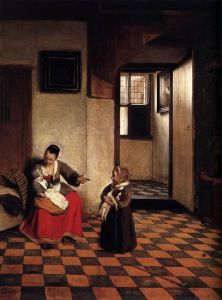
It was between the years 1655 and 1662 that de Hooch came of age as an artist and his work reached its peak of excellence. Though he would occasionally paint open-air scenes, almost all of his mature paintings were unsentimental interior and courtyard scenes, typically featuring two or three figures engaged in everyday domestic activities. There is, evident in paintings such as The Courtyard of a House in Delft (1658) and A Woman Preparing Bread and Butter for a Boy (c. 1660), a palpable atmosphere of calm and de Hooch perfected the skill of creating spacious and carefree effects through his masterly control of light, color, and compositional balance. Janson argues that de Hooch's mature works "are often so believable that they appear to be faithful records of actual sites" although they were "in significant part, fruit of the painter's imagination and compositional skill". Commenting specifically on de Hooch's preference for urban courtyards, meanwhile, the art historian Wayne Fantis - who credits the artist with the "invention of one of the most popular motifs in genre painting" - noted that courtyards were an "intrinsic feature of Dutch domestic architecture and were either constructed within the middle of a house or at its very back" where they would "provide light to their interiors". Fantis adds that de Hooch's "representations of courtyards, like his interior scenes, were, ultimately, contrived, skillfully combining direct observation of his immediate surroundings with prevalent pictorial conventions".
Late Period and Death
Though there are no official traces of his movements between 1657 and 1667, all indications are that de Hooch and his family settled in Amsterdam in the early 1660s, most likely due to the greater number of wealthy clientele residing there. Notwithstanding a documented visit to Delft in 1663, it is agreed that de Hooch practiced in the Amsterdam area for the rest of his life.
The move to Amsterdam was blighted by personal tragedy with two of his children succumbing to the bubonic plague. Little else is known of de Hooch's time in the city, other than he had regular contact with the painter Emmanuel de Witte and that he and his family lived (and attended church) on the city outskirts at Westerkerk. Most scholars agree that after his wife died in 1667 (aged 38) de Hooch's work lost much of it tenderness and delicacy. Indeed, his later compositions become more monumental in scale and his colors and lighting effects darker, coarser and generally more stylized. This deterioration in quality was quite possibly due to the grief of being widowed and the stress of raising his children on his own. De Hooch's son Pieter, who was also his pupil, died at Amsterdam's mental asylum in 1684 but how and when De Hooch himself died is unclear, though his last known work is dated 1684.
The Legacy of Pieter de Hooch
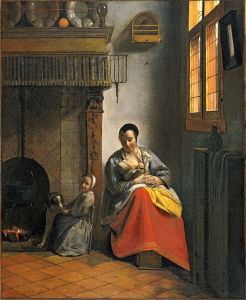
Although de Hooch has usually been eclipsed by Vermeer as the greatest Golden Age painter, it was he who did most to popularize genre paintings of domestic interiors and scenes of private family life. De Hooch has been taken to task by some historians for his "less than elegant" handling of the brush and his "below par" technique, but de Hooch's influence is unmistakable in the work of several eminent Northern European painters including Hendrick van der Burch, Ludolf de Jongh, Pieter Janssens Elinga, Esaias Boursse, and even Johannes Vermeer himself; the latter particularly in regard to lighting effects, his use of geometry and perspective, and a focus on domestic familial scenes.
It is perhaps de Hooch's pioneering use of the doorkirkjie - or "see-through-doorway" - that is his most unique legacy. It proved to be one of the most effective ways of achieving pictorial depth within the domestic space and allowed the painter to create more complicated architectural spaces and thus widen the scope for the pictorial narrative. The technique, which was adopted by Maes, De Witte, van Hoogstraten and Vermeer, even allowed for glimpses of city street life to be observed through open doors or windows. Moving beyond the realms of painting, and into the twentieth century, the Italian film director Luchino Visconti was renowned for framing domestic scenes in the "de Hoochian" way.
Influences and Connections

Useful Resources on Pieter de Hooch
- Pieter DE Hooch - Dutch School (Medici Masters in Colour Series) By Robert Rowe
- Pieter de Hooch Our Pick By Peter Sutton
- Pieter de Hooch: A Woman Preparing Bread and Butter for a Boy (Getty Museum Studies on Art) By Wayne Franits
- Masters of Painting: Pieter De Hooch By C. H. Collins Baker
- Pieter de Hooch: From the Shadow of Vermeer Our Pick By Anita Jansen
- 12 Facts about Pieter de Hooch, Master of Light and Serene Domestic Scenes By Sue Herdman / The Arts Society Magazine / October 25, 2019
- The School of Delft: Pieter de Hooch & Johannes Our Pick By Johnathan Janson / Essential Vermeer / 2020
- The Depiction of Servants in Some Paintings by Pieter de Hooch Our Pick By Wayne E. Franits / Zeitschrift für Kunstgeschichte / 1989
- What the Dutch Painter of Domestic Life Pieter de Hooch Can Teach Us About How to Embrace the Simple Joys of Staying Home By Allen Hirsch / Artnet / May 22, 2020
- A Delft Touch - the Intricate Patterns of Pieter de Hooch Our Pick By Kathryn Murphy / Apollo Magazine / December 10, 2019
- De Hooch - the Dutch Artist and Original Victim of the Vermeer Cult By Alastair Smart / The New European / January 9, 2020
- Painting in the Dutch Golden Age: A Profile of the Seventeenth Century (A Resource for Teachers) Our Pick By The National Gallery of Art, Washington / The National Gallery of Art, Washington / 2007
- New Exhibition Leads to Discovery of Dutch Painter's Signature and Fingerprint By Brigit Katz / Smithsonian Magazine / December 2, 2019
- The Dutch Golden Age: Contemporaries of Rembrandt and Vermeer Our Pick Museum of Fine Arts, Boston
- Pieter de Hooch in Delft: From the shadow of Vermeer Museum Prinsenhof Delft
Related Artists

Related Movements & Topics

Content compiled and written by Alexandra Duncan
Edited and revised, with Summary and Accomplishments added by Tony Todd
File : Pieter de Hooch - The Visit - WGA11684.jpg
File history, file usage on commons, file usage on other wikis.

Original file (1,244 × 1,500 pixels, file size: 165 KB, MIME type: image/jpeg )
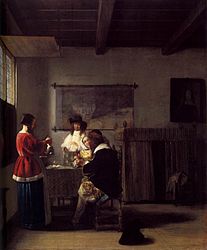
- Pieter de Hooch catalog raisonné, 1980 , 19
- Dutch Paintings in The Metropolitan Museum of Art. Volume I and II , 84
- Secretan sale 1889 , 128
- Tableaux anciens et modernes composant la collection de M.B. Narischkine , 16
- Peter de Hoogh catalogue raisonné, 1833 , 34
Click on a date/time to view the file as it appeared at that time.
You cannot overwrite this file.
The following 9 pages use this file:
- Catalogue of the celebrated collection of paintings by modern and old masters and of water colors and drawings formed by Mr. E. Secrétan
- Paintings by Pieter de Hooch
- Pieter de Hooch catalogue raisonné, 1908
- Pieter de Hooch catalogue raisonné, 1980 Sutton
- File:Pieter de Hooch - The Visit.jpg
- File:Pieter de Hooch - The Visit - WGA11684.jpg
- File:Pieter de hooch, la visita, 1657 ca., 01.JPG
- File:The Visit MET DP145400.jpg
- Category:The Visit by Pieter de Hooch
The following other wikis use this file:
- Louisine Havemeyer
- Wikipedista:Wesalius/Seznam děl Pietera de Hooche
- Benutzerin:Jane023/Gemälde von Pieter de Hooch
- Κατάλογος έργων του Μητροπολιτικού Μουσείου Τέχνης
- User:Jane023/Paintings by Pieter de Hooch
- Merry Company with Two Men and Two Women
- List of paintings by Pieter de Hooch
- User:Jane023/Paintings in the Metropolitan Museum of Art
- User:Pharos/ExistingMet
- User:Jane023/Dutch paintings in the MET
- User:Jane023/MET Louisine Havemeyer
- Utilisateur:Jane023/Liste des peintures de Pieter de Hooch
- Liste de peintures de Pieter de Hooch
- La Visite (Hooch)
- 陽気な仲間の二人の男と二人の女
- Gebruiker:Ophelia2/artikelen
- Het bezoek (Pieter de Hooch)
- Gebruiker:Jane023/schilderijen door Pieter de Hooch
- Lijst van schilderijen van Pieter de Hooch
- Wikidata:WikiProject sum of all paintings/Collection/Metropolitan Museum of Art/17th Century
- Wikidata:WikiProject sum of all paintings/Creator/Pieter de Hooch
- User:Pharos/sandbox
- Wikidata:Met Open Access Artworks Challenge/FR
- Wikidata:Met Open Access Artworks Challenge/DE
- Wikidata:Met Open Access Artworks Challenge/AR
- Wikidata:Met Open Access Artworks Challenge/RU
- Wikidata:Met Open Access Artworks Challenge/CA
- Wikidata:Met Open Access Artworks Challenge/IT
- Wikidata:Met Open Access Artworks Challenge/ZH
- Wikidata:Met Open Access Artworks Challenge/JP
- Wikidata:Met Open Access Artworks Challenge/SQ
- Wikidata:Met Open Access Artworks Challenge/NE
- Wikidata:Met Open Access Artworks Challenge/UK
- Wikidata:Met Open Access Artworks Challenge/BN
- Wikidata:Met Open Access Artworks Challenge/PT
- Wikidata:Met Open Access Artworks Challenge/HU
- Wikidata:Met Open Access Artworks Challenge/ML
- Wikidata:Met Open Access Artworks Challenge/TR
- Wikidata:Met Open Access Artworks Challenge/SV
- Wikidata:Met Open Access Artworks Challenge/PL
- Wikidata:Met Open Access Artworks Challenge/FA
- Wikidata:Met Open Access Artworks Challenge/EO
- Wikidata:Met Open Access Artworks Challenge/HE
- Wikidata:WikiProject sum of all paintings/Catalog/Dutch Paintings in The Metropolitan Museum of Art
- Wikidata:WikiProject sum of all paintings/Catalog/Secretan sale 1889
View more global usage of this file.
This file contains additional information such as Exif metadata which may have been added by the digital camera, scanner, or software program used to create or digitize it. If the file has been modified from its original state, some details such as the timestamp may not fully reflect those of the original file. The timestamp is only as accurate as the clock in the camera, and it may be completely wrong.
Structured data
Items portrayed in this file, digital representation of, main subject, source of file, file available on the internet.
- The Visit by Pieter de Hooch
- Images from Web Gallery of Art
- PD-Art (PD-old-100)
- Artworks with Wikidata item
- Artworks with accession number from Wikidata
- Artworks with known accession number
- Artworks digital representation of 2D work
- WGA form: painting
- WGA type: genre
- WGA School: Dutch
- WGA time period: 1651-1700
Navigation menu
Pieter Hendricksz. de Hooch
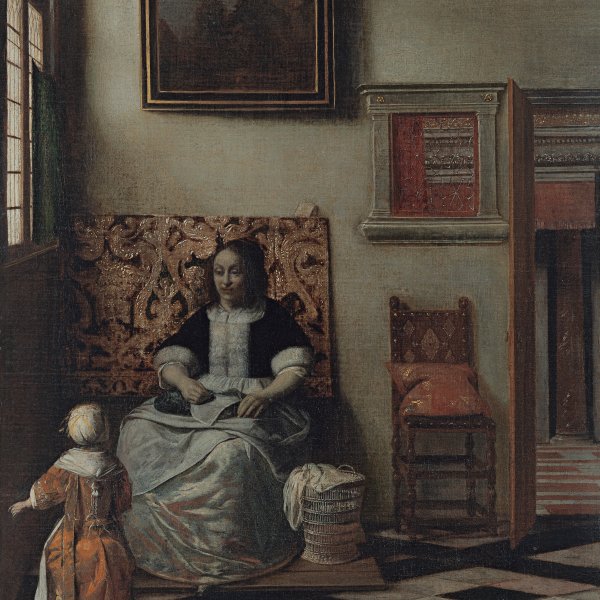
Products and publications

Interior with Two Women and a Man Drinking and Eating Oysters

Interior with a Woman sewing and a Child

Interior of the Council Chamber of Amsterdam Town Hall
Where next?
Explore related content
Pieter de Hooch ca. 1657
The metropolitan museum of art new york city, united states.
- Title: The Visit
- Creator: Pieter de Hooch
- Date Created: ca. 1657
- Physical Dimensions: 26 3/4 x 23 in. (67.9 x 58.4 cm)
- Type: Painting
- External Link: http://www.metmuseum.org/art/collection/search/436678
- Medium: Oil on wood
- Repository: Metropolitan Museum of Art, New York, NY
Get the app
Explore museums and play with Art Transfer, Pocket Galleries, Art Selfie, and more

The Visit (Q18511742)

Identifiers
Wikipedia (4 entries).
- enwiki Merry Company with Two Men and Two Women
- frwiki La Visite (Hooch)
- jawiki 陽気な仲間の二人の男と二人の女
- nlwiki Het bezoek (Pieter de Hooch)
Wikibooks (0 entries)
Wikinews (0 entries), wikiquote (0 entries), wikisource (0 entries), wikiversity (0 entries), wikivoyage (0 entries), wiktionary (0 entries), multilingual sites (1 entry).
- commonswiki Category:The Visit by Pieter de Hooch
Navigation menu
Pieter de Hooch, The Courtyard of a House in Delft
In the sunlight of a quiet afternoon this courtyard seems to radiate tranquillity. Everything is still, including the figures: a young maid, clean and calm, who holds the hand of a little girl, and the shadowy figure of a woman in the passageway to the left, presumably the child’s mother, who turns towards the houses opposite her own. De Hooch placed the mother in the formal part of the house, painted in architectural detail, while the maid and the child stand in an area closer to nature.
The picture shows de Hooch’s skill in depicting architecture, but it’s also a vision of women’s role in the stability of the home. At the time this was painted, treatises were being written on household and family management; Jacob Cats’s Houwelyck was addressed directly to women, its chapters divided into Maiden, Sweetheart, Bride, Housewife, Mother and Widow. Some artists, including de Hooch, presented pictures that were a confirmation and encouragement of the ideals put forward in such books.
In the sunlight of a quiet afternoon this courtyard seems to radiate tranquillity. Everything is still, including the figures. It is a posed image but not a portrait, nor a quick snapshot of life in seventeenth-century Holland. It is more than that. It shows Pieter de Hooch’s skills in depicting architecture but it is also a portrayal of tender human relationships and a vision of women’s role in domesticity and the stability of the home.
The picture is divided in two. On the left, painted with strong verticals and perspective, is the house and the passageway that leads through it. We see each mellow brick and stone of the arched doorway, already old when de Hooch was painting them, and below it, across the width of the picture, the intricate pattern of the courtyard tiles. On the right, framed by the strongly defined L-shape of the architecture, we see a tumbling vine on the fence, the chalky dust of the decaying wall and each rickety wooden plank of the log bin. The detail here is more freely painted than the bricks and tiles, with softer lines and colours taken from nature. The courtyard seems enclosed, though a number of openings seem to suggest otherwise. On the left, the bright red shutter hangs open, echoed on the right by the door at the top of the steps. The main door in the passageway is a link to the outside world.
A discarded broom in the foreground catches the eye. Sometimes this can symbolise a room that needs a good sweeping, both physically and morally, but in this picture it takes on another symbolic meaning: a well-ordered household. Things may be old and well-used but they are still spotless. Most of all, broom and bucket nod to the presence of the young maid on the step behind. They are her tools. She has performed all her duties and stands, clean and calm, holding the hand of the little girl.
Yet there seems to be an air of ambiguity about the image. We don’t know what is through the doorway at the top of the steps, nor do we know what the little girl holds in her apron or what’s in the maid’s dish. Above the archway is a tablet rescued from a nunnery once on the site of the house. Literally translated it reads: ‘This is in Saint Jerome’s vale, if you wish to repair to patience and meekness. For we must first descend if we wish to be raised’, but its meaning is unclear. In keeping with the subtlety of the rest of the picture, de Hooch has obscured these words behind a delicate web of leaves. Perhaps the greatest enigma is the shadowy figure of the woman in the passageway. Even in silhouette, she appears to be more expensively dressed than the maid and is presumably the child’s mother, yet she has distanced herself from them and turns towards the houses opposite her own. As the woman of the house, she would be responsible for its care but also for how her house and family were presented to the world.
There was a big change in household circumstances during the seventeenth century in Holland. For the first time, business was no longer done at home, with perhaps just one separate room near the front door for this activity. Men – and occasionally some women – now went out to offices or warehouses elsewhere in the city and the house became more and more the domain of women. Small treatises were written on household and family management. They were widely circulated and the most popular among them was Jacob Cats’s Houwelyck , distinguished from others in that it was richly illustrated and written in verse. Most importantly, Cats addressed his book directly to women rather than men – the chapters are divided into Maiden, Sweetheart, Bride, Housewife, Mother and Widow.
These treatises presented an ideal vision of marriage and domesticity totally at variance with the reality of daily life, but it seems that some artists, including de Hooch, took up their themes and presented pictures that were a visual confirmation and encouragement of the ideals they put forward. Others chose to approach them with wit and irony, as Jan Steen does in his painting The Effects of Intemperance . The treatises also paid great attention to the bringing up of children, especially girls, and paintings like de Hooch’s were bought to reinforce that message. Again, Steen produced an image more open to interpretation in his painting Grace before Meat – while the children appear well-behaved, the little girl’s eyes are fixed on the soup in a large tureen even while her hands are folded in prayer. But in the soft sunshine that warms the courtyard of de Hooch’s painting, the linked hands and the glance between maid and child suggest love and trust rather than strictness and convention.
De Hooch was a master of the depiction of architecture, of perspective and of the detail of objects and textures, but he was also a master of the perceptive portrayal of human relationships, so subtly revealed in this painting. He has placed the child and maid in the area of the courtyard closest to nature, and their linked hands and the glance between them seem to be far more than merely an instructive homily. We are witness to a private, intimate moment between the two – a child who loves and is loved in return.
Download a low-resolution copy of this image for personal use.
License and download a high-resolution image for reproductions up to A3 size from the National Gallery Picture Library.
This image is licensed for non-commercial use under a Creative Commons agreement .
Examples of non-commercial use are:
- Research, private study, or for internal circulation within an educational organisation (such as a school, college or university)
- Non-profit publications, personal websites, blogs, and social media
The image file is 800 pixels on the longest side.
As a charity, we depend upon the generosity of individuals to ensure the collection continues to engage and inspire. Help keep us free by making a donation today.
You must agree to the Creative Commons terms and conditions to download this image.

More paintings by Pieter de Hooch
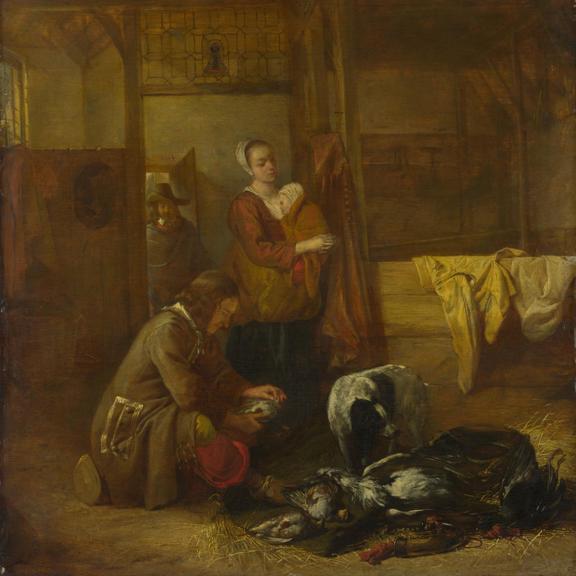

- Online Collection
- About the Collection
- Transparent Museum
- Das Hamburger Kinderzimmer
- Provenance Research
- Conservation

- Programme Formats

- Hiring space and Art Specials
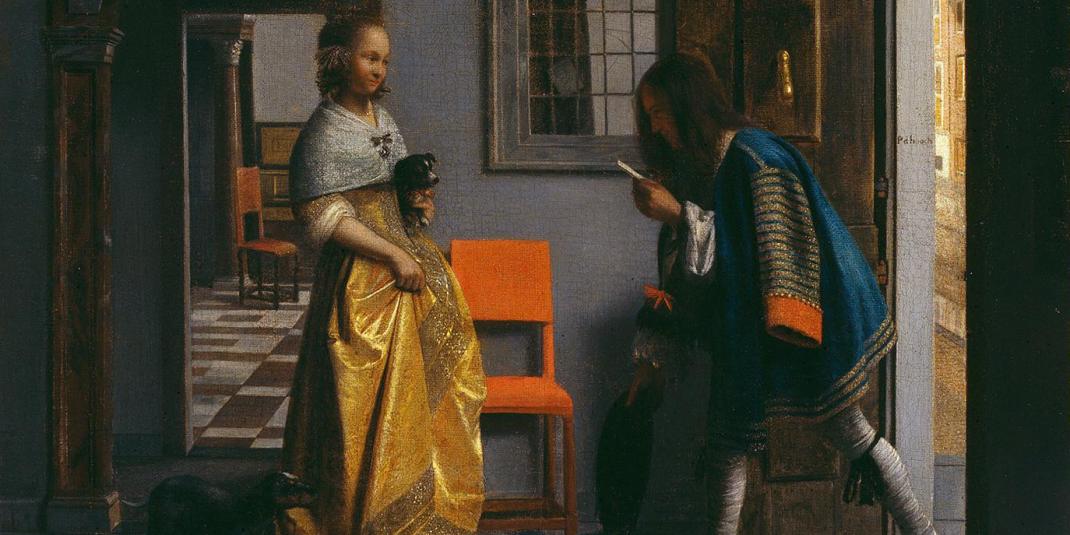
Pieter de Hooch
The Rotterdam painter Pieter de Hooch (1629–1684) was one the most prominent artists of the second half of the 17th century, the Golden Age of Netherlandish painting. Like Gerrit Dou, Gerard ter Borch, Caspar Netscher, Gabriel Metsu or Nicholaes Maes, he is often counted as one of the ‘fijnschilders’ or ‘fine painters’. The inimitable aura of their painstakingly conceived interiors and meticulously depicted moments in the lives of well-off Dutch citizens is characterized by an abundance of richly crafted detail and subtly modulated lighting. Since the state of preservation of such paintings can greatly influence how they are interpreted, their condition should by all means be taken into account. Following its extensive restoration, de Hooch’s The messenger of love is the focal point of this small display of carefully selected works by the artist and his contemporaries. For the first time it has at last become possible to again witness the special interplay of colour in this work, as well as its thematic motifs and the multifaceted relationship between the depicted figures. The language of love, of the figures’ gestures and physical presence, and of the illumination and texture are revealed as the work’s central theme.
What are you searching?
Frequently searched queries.
- Contemporary Art
- Long-term project for the conservation of slide-based artworks (2015-2018)

COMMENTS
Arthur de Rudder. Pieter de Hooch et son oeuvre. Brussels, 1914, p. 105, as "Deux dames et deux gentilshommes". W. R. Valentiner. "Pieter de Hooch, Part One." Art in America 15 (December 1926), pp. 47, 61, fig. 2, places it in the period between 1658 and 1663. Clotilde Brière-Misme. "Tableaux inédits ou peu connus de Pieter de Hooch."
Dimensions. 68 cm × 58 cm (27 in × 23 in) Location. Metropolitan Museum of Art, New York. Merry Company with Two Men and Two Women, also known as The Visit, is an oil -on-panel painting by the Dutch painter Pieter de Hooch, created c. 1657. It is an example of a Merry Company, a popular form of genre painting in Dutch Golden Age painting ...
The Visit Pieter de Hooch ca. 1657. The Metropolitan Museum of Art New York City, United States. Download this artwork (provided by The Metropolitan Museum of Art). Learn more about this artwork. Details. Title: The Visit; Creator: Pieter de Hooch; Date Created: ca. 1657; Physical Dimensions: 26 3/4 x 23 in. (67.9 x 58.4 cm)
Pieter De Hooch's oil on wood painting, The Visit, depicts a group of figures enjoying each other's company in a domestic setting. Measuring 26 3/4 x 23 inches, the painting falls under the genre of Merry Company and is characterized by its small size and finely nuanced observation of everyday living.
Pieter de Hooch (Dutch: [ˈpitər də ɦoːx], also spelled "Hoogh" or "Hooghe"; 20 December 1629 (baptized) - after 1683), was a Dutch Golden Age painter famous for his genre works of quiet domestic scenes with an open doorway. He was a contemporary, in the Delft Guild of St. Luke, of Jan Vermeer with whom his work shares themes and style. De Hooch was first recorded in Delft on 5 August ...
Pieter de Hooch 1629-1684 Dutch, painter and draftsman The Visit c. 1657. 67.9 x 58.4 cms | 26 1/2 x 22 3/4 ins Oil on wood Metropolitan Museum of Art Manhattan | United States H.O. Havenmeyer Collection, Bequest of Mrs H.O. Havenmeyer, 1929 ...
The Visit. 1657. Two women of uncertain reputation entertain visiting gentlemen. While rich in shadowy effects, this picture is one of the first in which De Hooch employed linear perspective to construct a realistic interior space (the bed, however, is underscaled). At the time, he was exchanging ideas with Vermeer, whose influence is evident ...
The Visit c. 1657 Oil on wood, 68 x 58 cm Metropolitan Museum of Art, New York: This painting, also titled as A Merry Company with Two Men and Two Women, is one of the first genre pictures by De Hooch in which the figures rise above the level of soldiers visiting inns and in which the setting makes tentative claims to gentility.
While not in good condition and a minor work by De Hooch, this panel is interesting for its place in the artist's development. It dates from about 1657-58 and, like The Visit (), represents a transitional phase between De Hooch's tavern scenes of the early 1650s and his domestic interiors and courtyard views of about 1658 onward.The earlier works recall Haarlem-style genre pictures in which ...
The Merry Company with Two Men and Two Women (1657) by Dutch artist Pieter de Hooch is a great example of how popular this type of painting was during the Dutch Golden Age. It shows a group of people who aren't supposed to be recognized as portraits having fun. It is now at the Metropolitan Museum of Art, New York.
Title: Leisure Time in an Elegant Setting. Artist: Pieter de Hooch (Dutch, Rotterdam 1629-1684 Amsterdam) Date: ca. 1663-65. Medium: Oil on canvas. Dimensions: Extended canvas 22 15/16 x 27 5/16 in. (58.3 x 69.4 cm); original visible painted surface 21 5/8 x 26 in. (55 x 66 cm) Classification: Paintings. Credit Line: Robert Lehman ...
Pieter de Hooch is best known for his pictures of the domestic life of women and children, such as 'The Courtyard of a House in Delft' in the Collection. His later paintings record fashionable life in the city of Amsterdam, and utilise a darker and richer range of colours. The son of a bricklayer, de Hooch was born in Rotterdam. According to his early biographer Arnold Houbraken, he was ...
Pieter Hendricksz de Hooch (occasionally spelled de Hoogh) was baptized in the Reformed Church in Rotterdam on December 20, 1629. His father was a master bricklayer and his mother a midwife. His only recorded teacher was the landscape painter Nicolaes Pietersz Berchem (Dutch, 1620 - 1683), with whom he studied in Haarlem along with fellow ...
Pieter de Hooch is best known for his skill at rendering domestic interiors, and for his invention of the doorkirkjie, or "see-through-doorway", ... Notwithstanding a documented visit to Delft in 1663, it is agreed that de Hooch practiced in the Amsterdam area for the rest of his life.
Media in category "The Visit by Pieter de Hooch" The following 5 files are in this category, out of 5 total. Pieter de Hooch - The Visit - WGA11684.jpg 1,244 × 1,500; 165 KB
Add a one-line explanation of what this file represents. Summary [edit]. Pieter de Hooch: The Visit : The Visit
Pieter Hendricksz. de Hooch. Rotterdam, 1629-Amsterdam, 1684. Print page. Pieter de Hooch was born in Rotterdam in 1629. According to the biographer of Dutch painters, Arnold Houbraken, he trained with the landscape painter Nicolaes Berchem, although that master's style is not evident in his early work. De Hooch's early scenes of taverns ...
Google Arts & Culture features content from over 2000 leading museums and archives who have partnered with the Google Cultural Institute to bring the world's treasures online.
painting by Pieter de Hooch
A Woman Drinking with Two Men. Pieter de Hooch. Not on display. Get all the latest news from the Gallery's Bicentenary year, updates on exhibitions, plus occasional offers and information on how to support us. Pieter de Hooch, The Courtyard of a House in Delft, 1658. Read about this painting, learn the key facts and zoom in to discover more.
The Visit. Pieter de Hooch. ca. 1657. Leisure Time in an Elegant Setting. Pieter de Hooch. ca. 1663-65. Paying the Hostess. Pieter de Hooch. ca. 1670. ... Pieter de Hooch. ca. 1657-58. Still Life with a Skull and a Writing Quill. Pieter Claesz. 1628. The Last Supper. Bernard van Orley. ca. 1525-28. The Harvesters. Pieter Bruegel the Elder.
The Rotterdam painter Pieter de Hooch (1629-1684) was one the most prominent artists of the second half of the 17th century, the Golden Age of Netherlandish painting. Like Gerrit Dou, Gerard ter Borch, Caspar Netscher, Gabriel Metsu or Nicholaes Maes, he is often counted as one of the 'fijnschilders' or 'fine painters'. The inimitable ...
Night and Day: A UD student's first impressions of the Cooch Homestead UD students envision a new future for Cooch's Bridge Historic Site. Students from the University of Delaware learning what it takes to develop plans for a historic site will be sharing their thoughts with the Delaware Division of Historical and Cultural Affairs (HCA), its supporters, and its newsletter subscribers ...